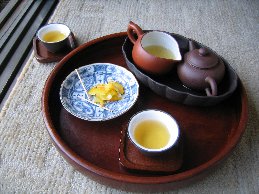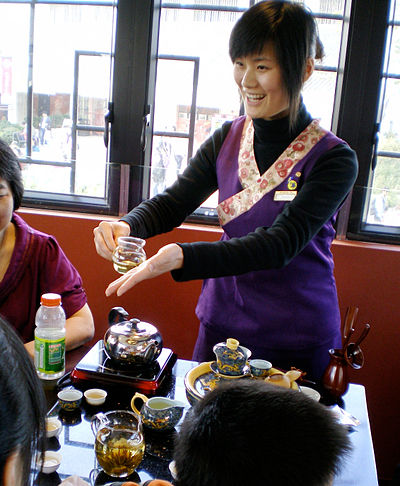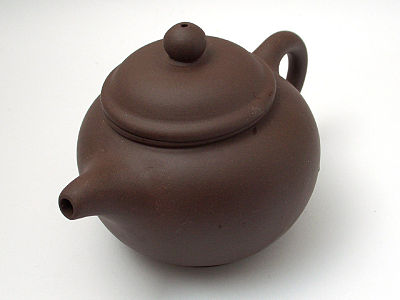Chinese tea culture
Chinese tea culture refers to the methods of preparation of tea, the equipment used to make tea and the occasions in which tea is consumed in China. The terms chayi "Art of Tea 茶藝" and Tea Ceremony have been used, but the term "Tea Culture 茶文化" includes more than just the ceremony. Also "culture" is easier to translate into English from the Chinese term "art 藝".
Tea culture in China differs from that of Europe, Britain or Japan in such things as preparation methods, tasting methods and the occasions for which it is consumed. Even now, in both casual and formal Chinese occasions, tea is consumed regularly. In addition to being a drink, Chinese tea is used in traditional Chinese medicine and in Chinese cuisine.
Tea drinking customs
There are several special circumstances in which tea is prepared and consumed.
- As a sign of respect
- In Chinese society, the younger generation always shows their respect to the older generation by offering a cup of tea. Inviting their elders to go to restaurants and having some tea is a traditional activity on holidays. In the past, people of lower rank served tea to higher-ranking people. Today, as Chinese society becomes more liberal, sometimes parents may pour a cup of tea for their children, or a boss may even pour tea for subordinates at restaurants. However, the lower-ranking person should not expect the higher-ranking person to serve him or her tea in formal occasions.
- For a family gathering
- When sons and daughters leave home because of work or get married, they may have few times to visit their parents, and parents may seldom meet their grandchildren as well. Therefore, going to restaurants and drinking tea becomes an important activity for family gatherings. Every Sunday, Chinese restaurants are crowded, especially when people celebrate festivals. This phenomenon reflects Chinese family values.
- To apologize
- In Chinese culture, people make serious apologies to others by pouring tea for them. For example, children serving tea to their parents is a sign of regret and submission.
- To express thanks to your elders on one's wedding day
- In the traditional Chinese marriage ceremony, both the bride and groom kneel in front of their parents and serve them tea. That is the most devout way to express their gratitude. In front of their parents, it is a practice for the married couple to say, "Thank you for bringing us up. Now we are getting married. We owe it all to you." The parents will usually drink a small portion of the tea and then give them a red envelope, which symbolizes good luck. Another variant is that the bride serve tea to the groom's parents, symbolizing that she is to become a part of the latter's family.
- To connect large families on wedding days
- The tea ceremony during a wedding also serves as a means for both parties to meet with each other. As Chinese families can be rather extended, and there may be one or two hundred people, it is entirely possible during a courtship to not have been introduced to someone. This was particularly true in older generations where the patriarch may have had more than one wife and not all family members were always on good terms. As such, during the tea ceremony, the couple would serve tea to all family members and call them by their official title. Drinking the tea symbolized acceptance into the family, while refusing to drink symbolized opposition to the wedding and was quite unheard of since it would result in a loss of "face". Older generations would give a red envelope to the matrimonial couple while the couple would be expected to give red envelopes to the unmarried younger ones.
- Folding the napkin in tea ceremonies is a traditional action and is done to keep away bad Qi energy in China as tea (茶) was regarded as one of the seven daily necessities. The others being firewood, rice, oil, salt, soy sauce, and vinegar(柴,米,油,鹽,醬,醋).
Finger tapping
Light finger tapping is a custom for thanking the tea master or tea server for tea. After a person's cup is filled, that person may knock their bent index and middle fingers (or some similar variety of finger tapping) on the table to express gratitude to the person who served the tea. Although this custom is common in southern Chinese culture such as the Cantonese, in other parts of China it is only acceptable if for some reason you cannot actually say thank you at that moment, for example if you are in the middle of talking with someone else at the table.
This custom is said to have originated in the Qing Dynasty when Emperor Qian Long would travel in disguise through the empire. Servants were told not to reveal their master's identity. One day in a restaurant, the emperor, after pouring himself a cup of tea, filled a servant's cup as well. To that servant it was a huge honour to have the emperor pour him a cup of tea. Out of reflex he wanted to kneel and express his thanks. He could not kneel and kowtow to the emperor since that would reveal the emperor's identity so he bent his fingers on the table to express his gratitude and respect to the emperor.
The bent fingers for knocking are technically supposed to be three to signify a bowing servant. One is the head and the other two are the arms.
It should be noted that in formal tea ceremonies nodding of the head and/or saying "thank you" is more appropriate.
Brewing Chinese tea
There are many different ways of brewing Chinese tea depending on variables like the formality of the occasion, the means of the people preparing it and the kind of tea being brewed. For example, green teas are more delicate than oolong teas or black teas and should be brewed with cooler water as a result. The most informal method of brewing tea is the simple adding of leaves to a pot, and hot water. This method is commonly found in households and restaurants, as at dim sum (點心) or yum cha (飲茶) in Cantonese restaurants. Two other primary methods of brewing tea are the Chaou method and the Gongfucha method. Chaou brewing tends towards a more formal occasion and is generally used for more delicate teas, medicinal teas and tea tastings. Gongfucha brewing is a far more formal method of tea brewing (mainly for oolong or double fermented teas like Pu-Erh) although even this method can be made more or less formal depending on the occasion. The first Ming Dynasty Emperor Hongwu contributed to the development of loose tea brewing by banning the production of compressed tea.
Chaou brewing
Gàiwǎn also known as a cover bowl(蓋碗/盖碗; lit., "lidded bowl"), also known as 蓋杯 (Pinyin: gàibēi; lit., "lidded cup") or 焗盅 (Pinyin: júzhōng; lit., "heat suffocation vessel") depending on the region of the China. "Gaiwan" is a relatively new word. This method of 'brewing' tea was originally developed by the Chaoshan people and its original name is Chá-ōu, 茶甌 (simplified 茶瓯). There are two words for brewing. One is chōng (沖) and the other is pào (泡). For chaou brewing, the word zhōng is used rather than pào.
The chaou is a three piece teaware consisting of a lid, cup/bowl, and a saucer. Chaous are generally made of porcelain or are glazed on the inside in order to prevent a buildup of tannins. The chaou may be used on its own or with tasting cups on the side. Chaou brewing is usually employed in tea tasting situations, such as when buying tea, where neutrality in taste and ease of access to brewing leaves for viewing and sniffing is important. This method of serving is often used in informal situations, though it can also be used on more formal occasions. Chaou brewing can be used for all forms of teas though lightly oxidized teas benefit most from this brewing method.
Gongfu chadao/ (tea ceremony) brewing
The Gōngfu Chá Dào (工/功夫茶道) also known as "工Gongfucha" or the "功 Kung Fu Tea Ceremony" is a relatively famous tradition of Minnan (閩南) and Chaozhou (潮州) or Chaoshan (潮汕). It makes use of small Yixing teapot of about 100 – 150 ml (4 or 5 fl.oz.) to enhance the aesthetics, and more importantly "round out" the taste of the tea being brewed. Yixing teapot brewing sides towards the formal, and is used for private enjoyment of the tea as well as for welcoming guests. Depending on the region of China the steps may differ, as will the tools used in the making of tea (e.g. Taiwanese-style Gongfu cha which makes use of several additional instruments including tweezers and a tea strainer). This procedure is mostly applicable to Oolong teas only although some use it to make Pu'erh and other double-fermented teas.
Tea ceremonies
The Chinese tea ceremony, also called the Chinese Way of Tea, is a Chinese cultural activity involving the ceremonial preparation and presentation of tea leaf. The manner in which it is performed, or the art of its performance is shown in the tea ceremony. Taoism has also been an influence in the development of the tea ceremony. The elements of the Chinese tea ceremony is the harmony of nature and enjoying tea in an informal and formal setting. Tea ceremonies are now being revived in China's new fast-paced culture, and continuing in the long tradition of intangible Chinese art.
Influence of tea on Chinese culture
Tea has had a major influence on the development of Chinese culture. Chinese traditional culture is closely connected with Chinese tea. In literature, arts, and philosophy, tea is often associated. Tea is connected closely with Taoism, Buddhism and Confucianism. Roughly, since Tang Dynasty, drinking tea is a must for self-cultivation. Chinese Chan (or Japanese Zen) philosophy is also linked with drinking tea.
Tea ware
Traditionally tea drinkers were regarded as the academic and cultural elites of society because the practice of drinking tea was considered to be an expression of personal morality, education, social principles, and status. Increased enthusiasm for tea drinking led to the greater production of tea ware, and also significantly popularized Chinese porcelain culture.
Teahouse
Chinese scholars have used the teahouse for places of sharing ideas. Teahouse is the by-product of Chinese tea culture but it also the historical evidence of Chinese tea history. Currently, people can also feel such a kind of humanistic atmosphere in Beijing like Lao She Teahouse and East China like Hangzhou, Suzhou, Yangzhou, Nanjing, Wuxi, Shaoxing and Shanghai and so on. It is still dynamic and vigorous.
Modern culture
In modern China, virtually every dwelling — even down to the simplest mud hut — has a set of tea implements for brewing a hot cup of tea. These implements are symbols of welcome for visitors or neighbors. Traditionally, a visitor to a Chinese home will be expected to sit down and drink tea while talking; the Chinese consider having such visits while standing to be uncouth. There are several types of tea: green tea, oolong tea, red tea, black tea, white tea, yellow tea, puerh tea and flower tea. Tea leaves are traditionally produced by constantly turning fresh leaves in a deep bowl. This process allows the tea to dry with its full flavor ready to be used.
Below are some Chinese tea ceremonies:
Teahouse
Traditionally, the elites of Chinese society have regarded particular teahouses as sanctuaries for sharing ideas. The teahouse was a place where political allegiances and social rank where said to have been temporarily suspended in favor of honest and rational discourse. As cited above, the leisurely consumption of tea was common in promoting conviviality and civility amongst the participants.
See also
- Tea ceremony
- The Classic of Tea
- Chinese tea
- China National Tea Museum
- Yum cha
- Culture of China
- Tea Classics
- Chinese social relations
- Chinese art
- Japanese tea ceremony
- Teaism
- Schools of Chinese Tea Ceremony
Tea cultures of specific traditions and regions
- Hong Kong tea culture
- Taiwanese tea culture
- Japanese tea culture
- Korean tea culture
- Assamese tea culture
- British tea culture






